Sweet Coconut Mochi (椰絲麻糬)
Warning: Parameter 2 to wp_hide_post_Public::query_posts_join() expected to be a reference, value given in /home/yirese5/public_html/wp-includes/class-wp-hook.php on line 287

I have never been a big fan of sweets throughout my life. Partially it is because I just love the “real cooked” food so much that I never end up having room for any dessert. However when I do feel like enjoying some desserts I tend to stick to a few of my beloved sweets. And mochi with sweet stuffing is definitely one of my favorites.
Mochi is the Japanese anme for glutinous rice cake. The origin of mochi is unknown, though said to come from China. The mochi itself does not offer much of taste but a soft and sticky texture. However, the real magic starts when you incorporate some flavors to the mochi and stuff it with some sweet filling such as red bean paste. The name Daifuku (means good luck in Japanese) was given to this kind of mochi and it is popular around the world.
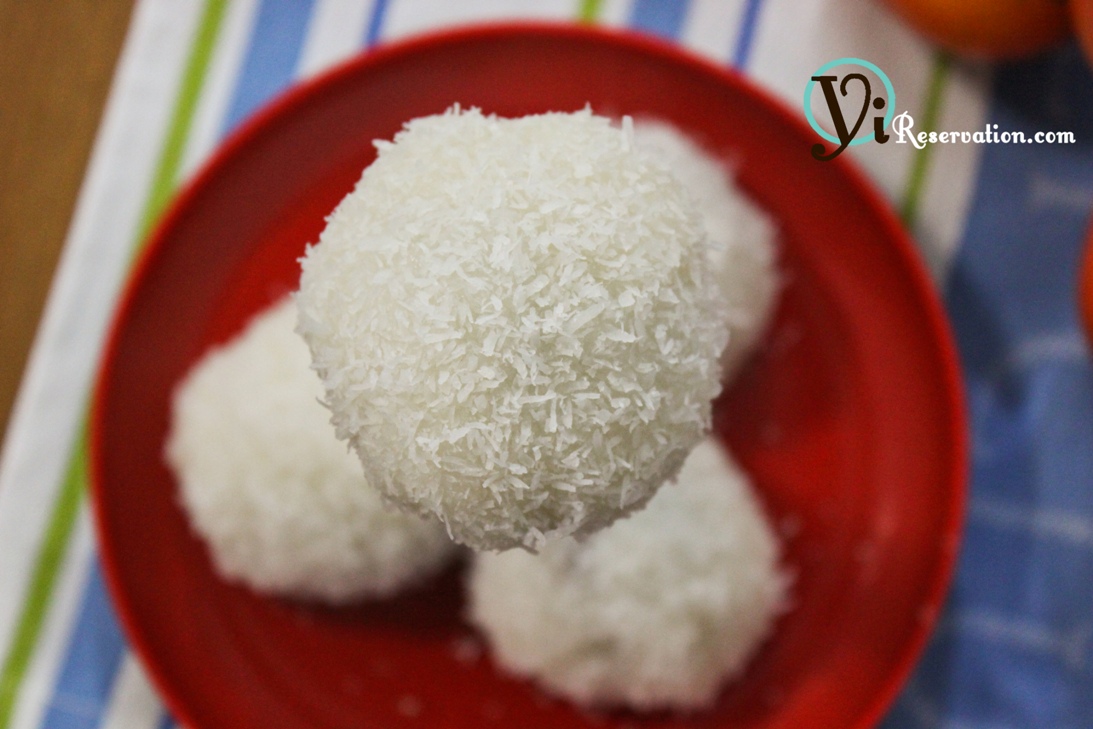
Although not a strictly Chinese dessert, mochi shares a lot of similarities with many of its Chinese counterparts such as sticky rice roll and Chinese sweet rice ball (湯圓). And of course, the same kind of red bean paste and glutinous rice flour have long been used in many Chinese cooking beyond just desserts As the first recipe in 2011, I would like to share this “good luck” mochi dessert with all of you and wish you a great Year of the Rabbit!

Before we get started I would like to introduce you to my first special guest to Yi Reservation – Alice C. Alice is a great home pastry chef as well as my fiancée. When she is in the kitchen she likes to whip up all sorts of desserts especially cookies, breads, cakes, and other baked goods. When I found out she also specialized in some Asian desserts I had to ask her to share this mochi recipe on Yi Reservation.
In this simple mochi recipe, you’ll need some glutinous rice flour (sweet rice flour) as well as red bean paste. Both of them can be purchased from Asian supermarkets. If you cannot find red bean paste, you might want to check out this red bean paste recipe.
I love coconut flavor so I used threaded coconut to finish the mochi. The coocnut mochi looks like a puffy stuffed bear’s fur. When the bear spotted the leftover he really wantes to take a bite on the sweet coconut mochi and green tea mochi. You can also easily substitute it with otherflavors such as green tea, chocolate, mango, orange, and etc. What is your favorite mochi flavor?
[stextbox id=”info” bgcolor=”9fdfd9″]Mochi Ingredients (make 10 mochi)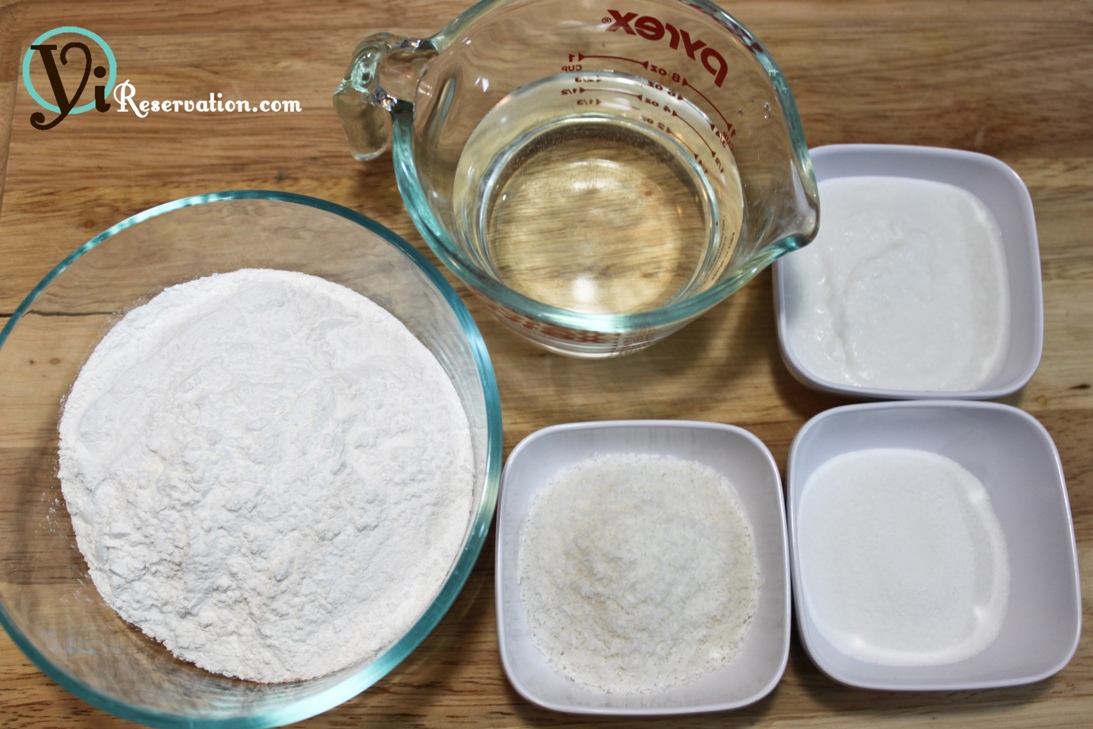
4.5 oz glutinous rice flour
1tbsp Sugar
2tbsp coconut milk
¾ cup water
2 drops of oil
Stuffing and Coating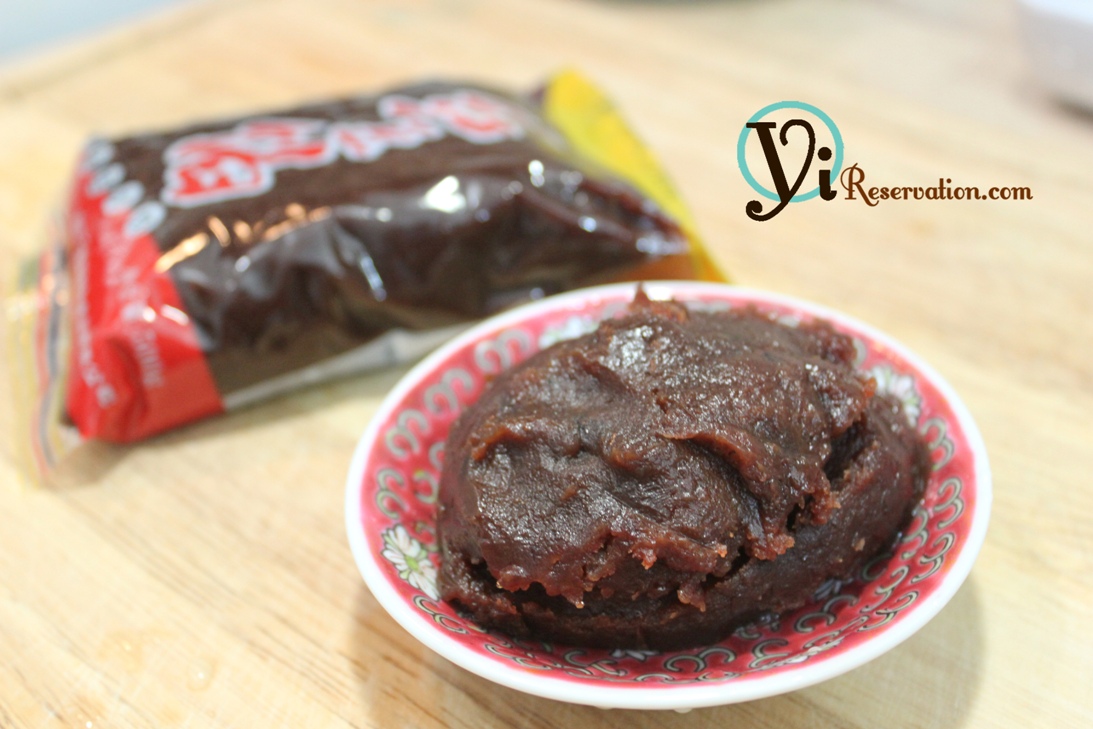
4 tbsp Sweet red bean paste
1 cup Threaded coconut
.
.[/stextbox]
[stextbox id=”custom”]Step-by-Step
1. To make mochi batter: in a mixing bowl, combine glutinous rice flour, sugar, and coconut milk. Add water gradually and mix well.
2. The batter should be somewhat liquid. Add 2 drops of oil at the end and mix well with the rest. Transfer the batter to a heat resistant container and steam it for 20 – 25 minutes over medium-high heat.
3. While waiting for the glutinous rice, shape the red bean paste into 1 inch diameter balls. These will be the filling.
[nggallery id=38]
4. Check the steamed rice mixture with a stick or chop stick. It should be completely solid. Cool it down for about 8 minutes until you can handle it by hands. Do not let it cool down to room temperature.
5*. Take 1 tbsp of rice cake and covered it in a plastic food wrap on both sides. Slightly press the cake to flatten it out.
6. Place the bean paste ball filling n the middle of the flat cake. Carefully wrap the rice cake around the filling.
[nggallery id=39]
7. As you fold the cake to wrap the filling and close the opening, make sure you shape the rice cake in a ball.
8. Dust the mochi with threaded coconut thoroughly.
[nggallery id=40]*Tips: alternatively you can also work with a pair of food prep gloves. The idea is to have a no stick surface when handle the rice cake.[/stextbox]
Warning: Use of undefined constant rand - assumed 'rand' (this will throw an Error in a future version of PHP) in /home/yirese5/public_html/wp-content/themes/yireservation/single.php on line 72
Warning: Parameter 2 to wp_hide_post_Public::query_posts_join() expected to be a reference, value given in /home/yirese5/public_html/wp-includes/class-wp-hook.php on line 287

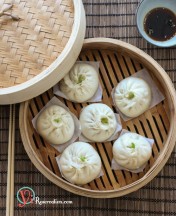

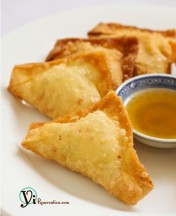
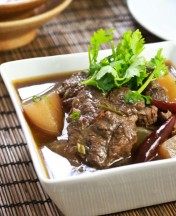
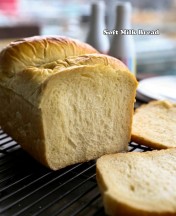
Pingback: Sweet Coconut Mochi (椰絲麻糬) - Rezepte
I am very eager to try this recipe but before I start I wanted to know if the “4.5 oz of rice flour” is taken from the weight of a scale or by the volume of a measuring glass (as seen on some measuring glasses). Thank you.
Hi Moriah, the rice flour is measured by weight on a scale. Thanks.
Hi,
My mochi comes out lumpy, do you know why? :p
hi Lily, thanks for checking out my recipe. There could be many reasons but I’d start with the batter. Is it possible that the flour wasn’t fully dissolved or had lumps?
would i be able to fill it with chocolate instead of red bean paste?
I think that’s a brilliant idea. Please let me know how it came out!
Pingback: Must try recipes to learn how to make coconut mochi | Mochihub.com
I am going to make these. I can already taste them in my mouth… I love mochi, even plain mochi. Mochi mochi mochi. Hehe.
Hi Alyssa, thanks for stopping by my blog. Please let me know how you like the recipe!!
Hi Yi, I would like to try this recipe but i prefer not to use coconut milk, is there any substitute and may I have the recipe in gm, please. thank you.
Hi yen, thanks for your visit. you can replace the coconut milk with regular milk but use extra threaded coconut. To convert the units please use this conversion website. I hope this helps. Thanks.
roasted black or white sesame seeds.
Los Mochi estuvieron deliciosos!!! Muchas gracias por la receta. Yo les preparé un poco diferentes les cociné en agua hasta que suban y no a fuego fuerte si no lento una vez arriba los saqué y les banié en coco rallado y los otros en sésamo negro!!
Gracias por la receta muy ricos
Hi Sausana, thanks for your comment. Although my Spanish skill is non-existent, I was able to get the message through the wonderful google translator. I am glad you were able to modified the recipe to suit your preference. Thanks for the kind feedback!
Hola Yi! Mi inglés esta durmiendo en el sotano! Pero si hablas aleman sería una posibilidad para agradecerte nuevamente por tu receta. Esta semana compre mochi en una tienda china pero debo confesar que tu receta es la mas facil y mejor!
Gracias por comentario.
Danke schön!!
Hi Danke, thank you for the feedback. Google translator once again saved my life. I am glad that you have found my recipe easy and delicious. Happy cooking!!
What exactly do you use to steam it? I’ve only ever baked mine, but I’d like to try steaming it.
Hi Gill, thanks for your visit. You can pretty much use anything from serving bowls to glass containers to steam the rice dough. I normally steam this in big wok that’s half-filled with water. I hope this helps!
thanks,
Pingback: Homemade Sweet Red Bean Paste (Azuki Bean Paste) | 紅豆沙 | Yi Reservation
Pingback: Sweet Red Bean Paste Rolls | Yi Reservation
This is a great find! Coconut mochi is my favorite and I’ve been looking for a recipe so that I won’t have to go downtown to cure my mochi cravings. I was wondering what the procedure would be if this recipe was cooked in the microwave? Would the liquid to rice flour ratio be changed at all?
Hi Mae, thanks for checking out the recipe. I’ve done making the mochi in the microwave and from my experience you’ll need a slightly more water than the required amount. also try to cover the container when you microwave the rice flour mix so it doesn’t get too dry. Please let me know if you have any other questions.
Followed your exact recipe to make mochi. No good. It’s very sticky. It’s not pure white compared to restaurant.
Hello, thanks for your feedback. I think the kind of “pure white” mochi you are referring to is the variety that’s coated with either corn starch or powder sugar. This variety in this recipe is coated with threaded coconut. Mochi is made of rice flour so it is very sticky (at least when it’s warm) by itself that’s why you need to coat it some dry stuff such as coconut or corn starch/powdered sugar. Hope this helps.
in the recipe there is no mention what to do with green tea
aha great catch! originally I was thinking of posting a recipe for the green tea mochi together with the coconut mochi. I must have forgotten to completely delete the green recipe part. Thanks for point it out Jac! I have fixed the issue.
Please tell Alice, this is really the best Mochi I’ve ever had in the US. I made this over the weekend. I made a grinded mixture of pecan, walnut, black sesame, and sugar then sprinkle the mochi with it. It’s just like the ones from Taiwan street vendors’. They were so good! Thank you!
Hi Janet, Alice and I are so happy to hear from you. We were just talking about you the other day.
I am glad that you like the recipe and you make use of it. Hope all is well with you and your family!
I had some mochi similar to this at a chinese buffet once, but it appeared to be steamed and had a yellowish white center. What could this be?
Hi Eli, thanks for visiting. How does the stuffing of the mochi taste like? I have not had mochi with yellowish white stuffing but I’d guess it’s probably some sort of custard stuffing.
It had a sweet and almost almond flavor, it was definitely custard. It was shaped similarly to a potsticker, but the outside was made from glutinous rice dough with coconut on top, they were served hot.
I think this is a mochi but in a shape of dumpling. The filling sounds like a typical custard filling you find in a lot of Chinese bakery stores or dim sum restaurants. It sounds like a great idea to combine the texture of glutinous rice with some delicious custard filling!
This is so late haha but it’s actually a chinese dessert. It looks exactly like the mochi you made, however the texture and filling is completely different. This traditional chinese dessert has been around since forever, with the coconut not being an add-on option like in Japan, but is originally intended to always be made with it. The “mochi” part of the Chinese kind is actually much much thicker and less sticky. Also, the yellowish filling you were describing is actually lotus seed paste. Usually it is translucent and white-ish in color. Hope this helped 🙂
Thanks Ashley!
Pingback: Uni Soba Martini | Yi Reservation
Thank you very much for the recipe.
I’ve tried the recipe on the link above about how to wrap mochi (Youtube vid by cookingwithdog). I followed her ingredients and the mochi is much harder in texture. My mother says that’s the Japanese style.
However, my mother loves the softer texture which is more Chinese style and she loves your recipe which I followed. She’s quite hard to please so big thumbs up 🙂
In regards to wrapping, I’ve not tried using plastic gloves or wrap. I use the more traditional method of potato starch on hands and working surface but it’s quite messy but fun.
Hi Alex,
I appreciate for your feedback. I’ve yet tried the recipe from cookingwithdog, although I’ve probably have watched of the videos – many times.
If you want to be adventurous, you can also try out different stuffing and coating. I experimented the mochi with lotus seed paste stuffing and matcha (green tea powder) coating. They came out excellent!
Thanks again and hopefully you find more interesting recipes on this site!
Pingback: Peanut Butter in Your Heart Chocolate Cookies (心軟花生醬曲奇) | Yi Reservation
I had the pleasure tasting it, better than the ones I got from Flushing Bakery. Good Job Alice
THANK YOU for posting this recipe! I have been searching for how to make Chinese red bean-filled mochi. There is a small bakery in Chinatown that makes my favorite, but I would love to make it at home. My mom calls them “Chinese snowballs”.
I got hooked on mochi from this japanese dessert shop and since then I’d stop by here and there to get my mochi fix. “Chinese snowball” sounds like an accurate description of these lovely soft sweet goodness. Hope you get to make this at home.
Nice!! I didn’t know you can make this. Looks totally legit!
Hi Miranda, thanks for stopping by. I wish I could make this myself but it’s all Alice.
My favorite desserts, thanks. I am going to try that this week.
Hi Amy, I am glad you are going to try it. Please let me know how it came out.
what’s the difference between 麻糬 and 糯米滋?
Hi Kat, I believe they are the same. It just got more famous under the Japanese name mochi (麻糬).